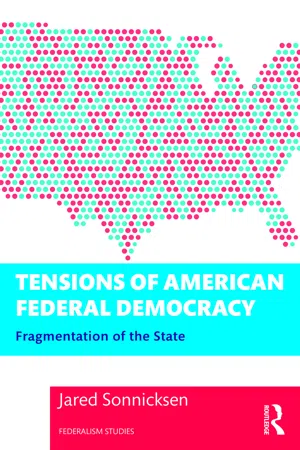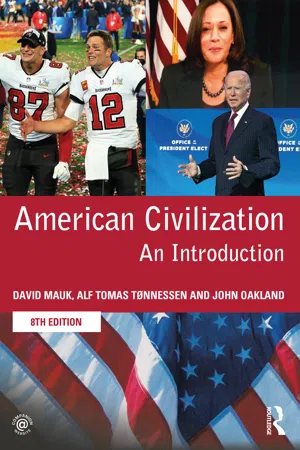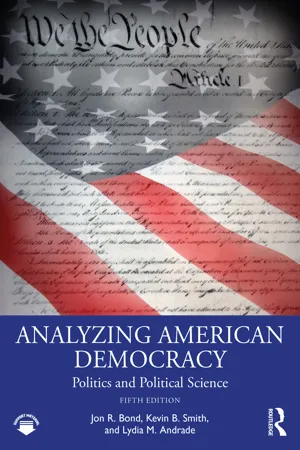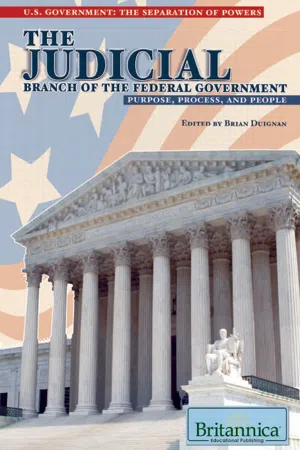Politics & International Relations
US Constitution
The US Constitution is the supreme law of the United States, outlining the structure of the federal government, the rights of the people, and the relationship between the government and its citizens. It was ratified in 1788 and has since been amended 27 times. The Constitution serves as the foundation for the country's political system and is a cornerstone of American democracy.
Written by Perlego with AI-assistance
Related key terms
8 Key excerpts on "US Constitution"
- eBook - ePub
- Robert J. McKeever, Philip Davies(Authors)
- 2014(Publication Date)
- Routledge(Publisher)
Part 1 The constitutional dimension of American politicsIt is no exaggeration to say that Americans view their Constitution with the kind of reverence usually reserved for religious texts. This is not so surprising once we recall that the US Constitution was effectively the founding text of the newly independent country and that it has served the nation for over 200 years. In a very real sense, then, the Constitution is synonymous with the American people as well as their government. It is the source of the people’s rights and it has enabled them to stand up to their government when it has sought to oppress them. More prosaically, but equally important, the Constitution provides the framework for the key institutions and processes of national politics and for the relationship between the federal government and the governments of the 50 states. Any study of the government and politics of the United States must, therefore, begin with an examination of the Constitution. In Chapter 2 , we analyse the origins of the Constitution: its genesis in the political flux created by the successful war for independence, the principles upon which it was based and the institutions and political processes it established. In Chapter 3 , we examine in detail the operation of federalism in the United States: in particular, we analyse the historical development of the division of powers between the federal government and the states and assess the importance of federalism in contemporary government.Contents Chapter 2 The Constitution and constitutionalism Chapter 3 FederalismPassage contains an image
Chapter 2 The Constitution and constitutionalismThis chapter examines the origins, development and impact of the single most important document in American politics – the Constitution of the United States. The Constitution provides not only a framework for government in America, but also a way of thinking about government. For inseparable from the Constitution is the idea of constitutionalism – the belief that all things governmental and political must comply with the principles set out in that document. The US Constitution was drafted in 1787 and came into force in 1789. Yet it is no mere historical relic. Because it has been regarded as a ‘living document’, subject to new interpretations as well as formal amendment, it has developed in line with the socio-economic and political transformation of America from a rural, eastern seaboard nation to a post-industrial, continental power that dominates the world in so many respects. As you might expect, just as America has not achieved this transformation without struggle and contention, so too the Constitution has been fought over and its development has been far from smooth. Nevertheless, it remains the keystone of American government and any understanding of American politics must begin with an appreciation of the Constitution and constitutionalism. - eBook - ePub
Tensions of American Federal Democracy
Fragmentation of the State
- Jared Sonnicksen(Author)
- 2022(Publication Date)
- Routledge(Publisher)
The US Constitution would come to be perceived as encompassing the revolutionary principles of American independence and a variety of immanent constitutional principles – e.g. democracy, federalism, separation of powers, limited government, and individual liberties and rights. They are implied and in parts literally expressed or legible based on concrete wordings. The US Constitution does not realize any of its principles of course. But it can be read as having done so as well as implying or meaning an embodiment of substantially different governmental orders at once. In addition to the veneration of the founding, the Founders, Independence, and Revolution, this development was also enabled through the conversion of large political changes into constitutional ones. They started to be integrated, “read” into, and superimposed upon the same constitutional text practically from the outset. The dynamics of constitutional politics evolving in a feedback loop of multiple meanings and within the mostly same formal framework over time have continued, though with intermittent disruptions, into the present. Integration with interpretation would turn out to be the case already for early notable critical junctures like the “Jeffersonian” (1800) and the later “Jacksonian” (1828) democratic “revolutions”, as well as later ones like the New Deal of the 1930s, desegregation and the Civil Rights movement of the 1950s, and the New Federalism of the 1980s. Each of these would have or coincide with implications on the further development of the state, federalism, and democracy at work, yet with the persistence of the predominantly same formal constitution in writing - eBook - ePub
- Cynthia Metcalf, Rhonda Atkinson, Rhonda Atkinson(Authors)
- 2017(Publication Date)
- Research & Education Association(Publisher)
Research has been theory-based, values-neutral, and concerned with predicting and explaining political behavior. COMPETENCY 3.1 Identify the features and principles of the U.S. Constitution, including its amendments, the separation of powers, checks and balances, and federalism. Features of the U.S. Constitution Constitutional Foundations The government of the United States rests on a written framework created to strengthen a loose confederation that was in crisis in the 1780s. The Constitution is a basic plan that outlines the structure and functions of the national government. Clearly rooted in Western political thought, it sets limits on government and protects both property and individual rights. Historical Background Following the successful revolt of the British colonies in North America against imperial rule, a plan of government was implemented that was consciously weak and ultimately ineffective, the Articles of Confederation. The Articles served as the national government from 1781–1787. The government under the Articles consisted of a unicameral (one house) legislature that was clearly subordinate to the states. Congressional representatives were appointed and paid by their respective state legislatures and their mission was to protect the interests of their home states. Each state, regardless of size, had one vote in Congress, as had been the case in the Continental Congress, which could request, but not require, states to provide financial and military support - eBook - ePub
- David L Hudson(Author)
- 2010(Publication Date)
- Visible Ink Press(Publisher)
THE U.S. CONSTITUTION
What is the primary source of law in the United States?
The primary source of law is the U.S. Constitution, which serves as the blueprint for the country’s legal system. It is the highest form of law. States also have their own constitutions, which serve as their highest forms of legal documents. If a law does not comport with the Constitution, the law is declared unconstitutional or void.What this means is that other forms of law must comport with the Constitution. In other words, a common legal claim asserted by a party challenging a law is that the law is unconstitutional. This means that the law violates a provision of the Constitution and is unenforceable.What exactly does the U.S. Constitution do?
This most fundamental of all legal documents defines and limits the powers of the federal government. It also separates and defines the powers of this federal government into three branches of government—the legislative, executive, and judicial branches. The Constitution also establishes the baseline between the federal government and various state governments.How is the U.S. Constitution composed?
The U.S. Constitution is composed of seven articles. The first three articles are the longest and arguably the most important. These three articles explain the powers of the three branches of government—legislative, executive, and judicial. Article I of the Constitution outlines the powers of the U.S. Congress. Article II outlines the power of the president—the chief officer of the executive branch. Article III outlines the powers of the judicial branch.The U.S. Constitution is the fundamental document that establishes a balance of power between the branches of the federal government, as well as for indicating what powers are under state or federal control (iStock).Article IV deals with the states and how the laws of one state are treated in other states. It also deals with how to admit a state to the union. Article V describes the amendment process. Article VI—a very short part of the Constitution—contains the Supremacy Clause, which ensures that federal law and the Constitution are the highest law of the land. Article VII consists of a single sentence explaining that it would take nine states to ratify the Constitution. - eBook - ePub
American Civilization
An Introduction
- David Mauk, Alf Tomas Tønnessen, John Oakland(Authors)
- 2021(Publication Date)
- Routledge(Publisher)
The Constitution defines federalism through the concepts of “reserved” and “delegated” powers in the Tenth Amendment. It reserves to the states or people those powers not specified in or reasonably inferred as federal from the Constitution’s wording. American federalism is a system in which the national government and the states share the governing power (sovereignty). The states delegated some powers to the national government in 1787 but reserved most powers for themselves. The rights reserved for the people in the preamble of the Constitution and the Bill of Rights limit the powers of the federal government and the states. The preamble stresses popular sovereignty (the idea that “the people” are the power behind government). The people created the government and can alter or replace it.Judicial review
The US has a hierarchy of law. The federal constitution is the supreme law. Acts of Congress signed by the president, as well as state and local laws, must conform to it. State and local laws must also conform to federal statutes and the state constitution. This legal hierarchy led the federal Supreme Court toPLATE 6.1The Capitol, Washington, DC.Source: Wes Thompson/Getty Imagesassume the role of final interpreter of the US Constitution through “judicial review.” Connecting state and national law, the court decides what government activity is permissible on any level. The US Constitution limits judicial review, however, to “cases and controversies.” This means the court cannot interpret the constitutionality of a law unless someone brings legal charges against that law to a lower court and appeals the case to the US Supreme Court.The Constitution’s broad language has allowed the Supreme Court to expand federal power into areas originally reserved to the states. Congress, for example, has extended its activities through clauses giving it broad power to regulate commerce, provide for the general welfare and create all laws that are “necessary and proper” to carry out the other powers granted to the federal government in the Constitution. In practice, therefore, government activity in the US today falls into three categories: that allowed the states alone, that permitted only to the national government and that shared by both levels of government.The separation of powers
The third basic principle in the Constitution is the separation of powers among the legislative (Congress and support agencies), executive (the president and executive bureaucracy) and judicial (the US Supreme Court and other federal courts) branches. In this non-parliamentary system, no person may serve in more than one branch at the same time. Thus, the president and the heads of the executive departments, as well as federal judges, may not - eBook - ePub
Analyzing American Democracy
Politics and Political Science
- Jon R. Bond, Kevin B. Smith, Lydia Andrade(Authors)
- 2023(Publication Date)
- Routledge(Publisher)
Constitution is that it is a written document. Although we tend to take this for granted, at the time of America’s founding, a written constitution was quite innovative. Before the American and French Revolutions, a constitution was conceived as something that evolved from a nation’s history and practice. The notion that a constitution could be “drafted” was met with contempt in England. English writer Arthur Young ridiculed the American and French idea of a written constitution as “a new term they have adopted; and which they use as if a constitution was a pudding to be made by a recipe” (quoted in Pritchett 1976, 2; Zink 2009, 442). A written constitution essentially reverses the traditional view. As political scientist C. Herman Pritchett explains, the Founders’ view was that a constitution was a formal written instrument, a “social contract” drafted by a representative assembly and ratified by a special procedure for determining public assent. … The constitution brought the government into existence and was the source of its authority. The government was the creature of the constitution. (1976, 2) Recall that a constitution defines the fundamental rules and powers under which government operates. It also establishes the “rule of law” so that no one, not even the lawmakers, is above the law. The discussion and debate at the Constitutional Convention focused on creating a stronger central government that would protect individual liberty. James Wilson, one of the most influential delegates, offered a comprehensive theory of the written American Constitution. An analysis of Wilson’s writings (Zink 2009) shows that he agreed that the primary purpose of the Constitution was to secure individual liberty based on natural rights. Yet Wilson recognized the inherent tension between the notion of inalienable natural rights and the need to establish a common identity in the new nation - eBook - ePub
The Judicial Branch of the Federal Government
Purpose, Process, and People
- Britannica Educational Publishing, Brian Duignan(Authors)
- 2009(Publication Date)
- Britannica Educational Publishing(Publisher)
ONSTITUTIONAL BACKGROUNDTHE ARTICLES OF CONFEDERATION AND THE CONSTITUTION OF THE UNITED STATES
The U.S. Constitution, which provides the principles of government for the United States, is a landmark document of the Western world. It is the oldest written national constitution in use and was the first to provide constitutional protections for its citizens against government infringement. Adopted in 1789, the Constitution divides governmental authority between a central national government and various separate state governments. It defined the principal organs of government and their jurisdictions as well as the basic rights of citizens, but it was not, however, the first such document created for the task in the United States. Its predecessor, the Articles of Confederation, was a kind of template for the Constitution, providing the new nation with its first, instructive experience in self-government under a written documentThe Articles of Confederation, in force from 1781 to 1789, served as a bridge between the early government by the Continental Congress during the Revolutionary period and the federal system of government provided under the U.S. Constitution. Because the experience of overbearing British central authority was vivid in colonial minds, the drafters of the Articles deliberately established a confederation of sovereign states. Their intention is manifest in the name of the new nation, established in Article I: the United States of America. The Articles were written in 1776–77 and adopted by the Congress on Nov. 15, 1777. However, the document was not fully ratified by the states until March 1, 1781.PRIMARY SOURCE: THE ARTICLES OF CONFEDERATION (EXCERPTS)Articles of Confederation and Perpetual Union Between the States of New Hampshire, Massachusetts Bay, Rhode Island and Providence Plantations, Connecticut, New York, New Jersey, Pennsylvania, Delaware, Maryland, Virginia, North Carolina, South Carolina, and Georgia.Article I - eBook - ePub
American Politics
A Beginner's Guide
- Jon Roper(Author)
- 2011(Publication Date)
- Oneworld Publications(Publisher)
As colonial unrest at the perceived injustices associated with British imperial rule grew during the last half of the eighteenth century, Americans argued that Blackstone’s portrait of British government had become blurred beyond recognition. In the Declaration of Independence, Jefferson’s criticism of George III was that he had become a tyrant and had undermined the balance of power between the monarch and Parliament. Nevertheless, Montesquieu’s analysis still retained its appeal for many American colonists. What Adams and his contemporaries extracted from it was the idea that a separation of powers could be based not on social classes but on government functions: the Legislature which passed the laws, the Executive which oversaw their operation and the Judiciary which arbitrated their constitutionality. When it was combined with the principle of federalism, therefore, this formulation of the concept of a separation of powers would become the animating spirit of the American Constitution.Recognizing the need to separate the legislative, executive and judicial functions of government did not mean the creation of a system in which there would be no political interaction between them. On the contrary, as Adams had appreciated, the challenge of creating a government in which each institution could be held accountable for its actions lay in determining the balance of powers between them and allowing each to check the others. So the American Constitution outlines how Congress, the President and the Supreme Court should work together to restrain and verify the actions each is empowered to undertake.The President can veto legislation passed by Congress, but the veto may be overturned. However, the Supreme Court can still declare a law to be unconstitutional. The Executive can appoint members of the Supreme Court and make treaties with foreign powers, but subject to Senate approval. Both Houses of Congress can initiate legislation but the final version of any law has to be agreed between them. The House of Representatives can build a case for the President’s impeachment, but that case is then tried before the Senate with the Chief Justice of the Supreme Court presiding. These are a few examples of the ways in which the Constitution of the United States, in its intricate and ingenious design, creates a system of government of – in the apt phrase used by the political scientist Richard Neustadt – “separated institutions sharing powers.”Where powers are not clearly demarcated between institutions or indeed between the federal and state governments, the Constitution sets in motion a political dynamic in which their relationships are constantly being re-negotiated. Both Congress – notably the Senate – and the President have influence over the nation’s foreign policy. This can and does lead to friction between them. Similarly, at least until the end of the Civil War, the struggle over whether to permit or prohibit slavery in new states which joined the Union meant that the borders between federal authority and state autonomy were constantly shifting as the nation expanded westwards.
Index pages curate the most relevant extracts from our library of academic textbooks. They’ve been created using an in-house natural language model (NLM), each adding context and meaning to key research topics.







